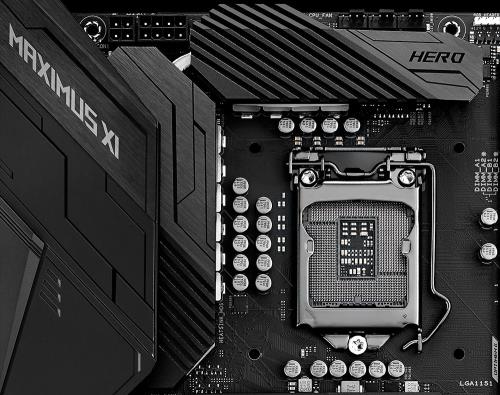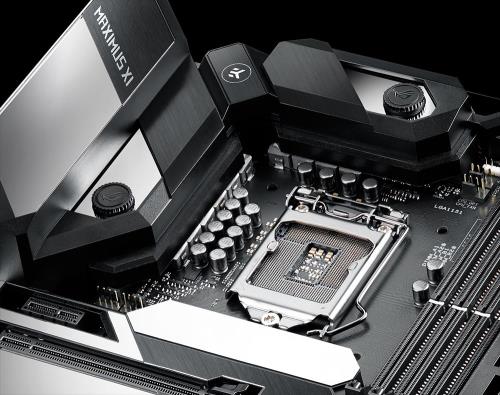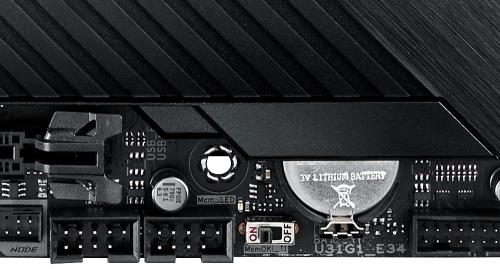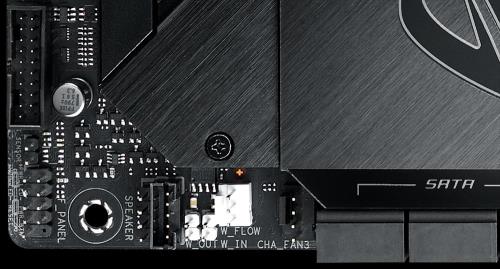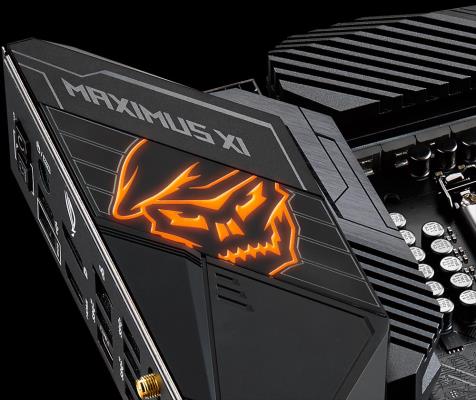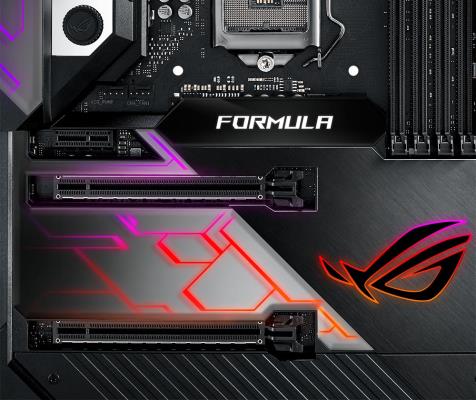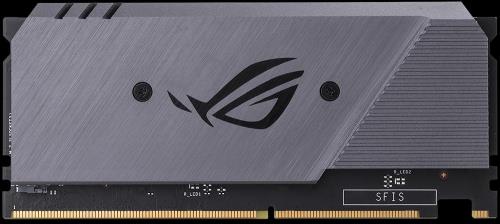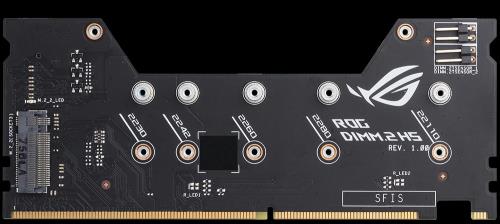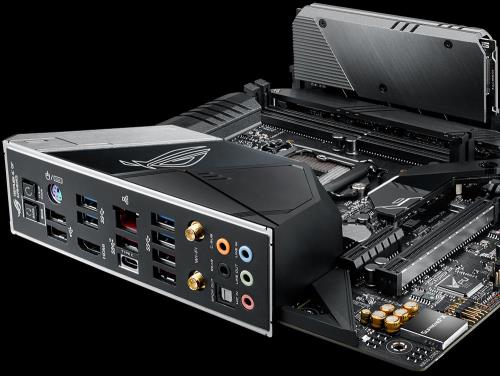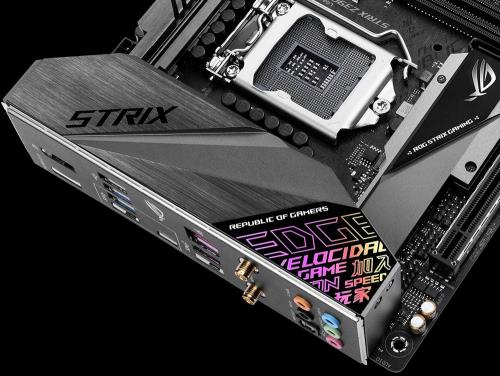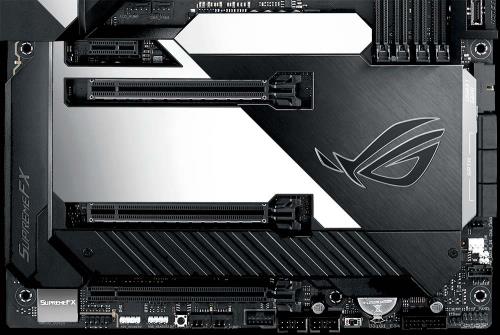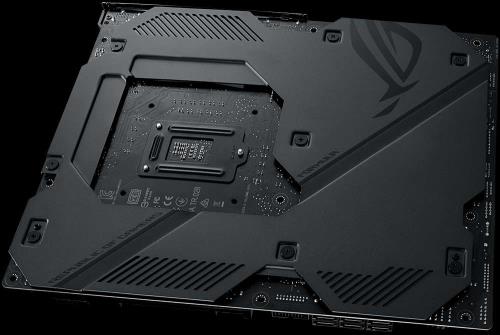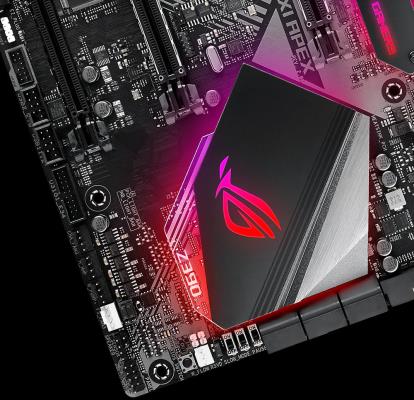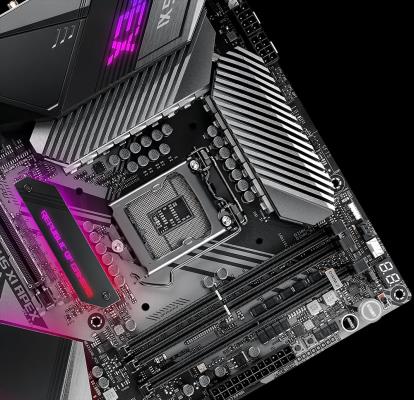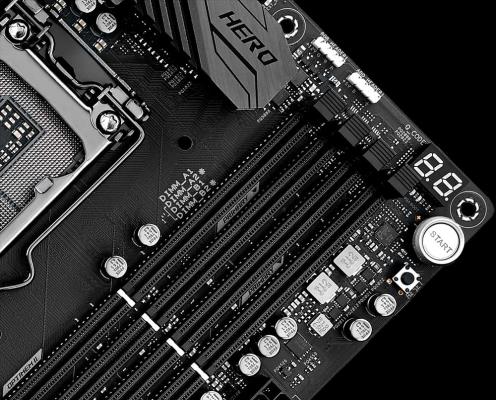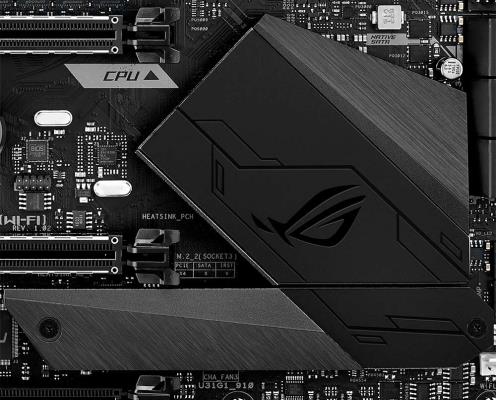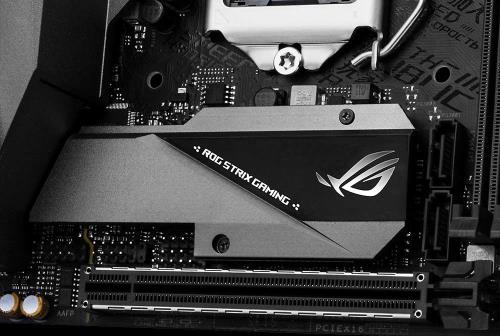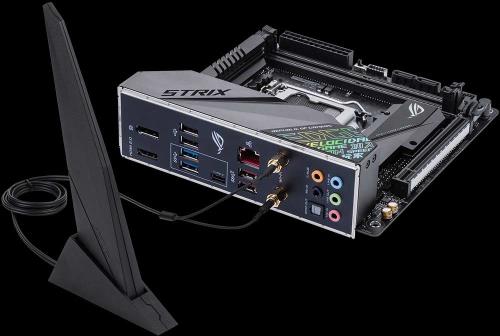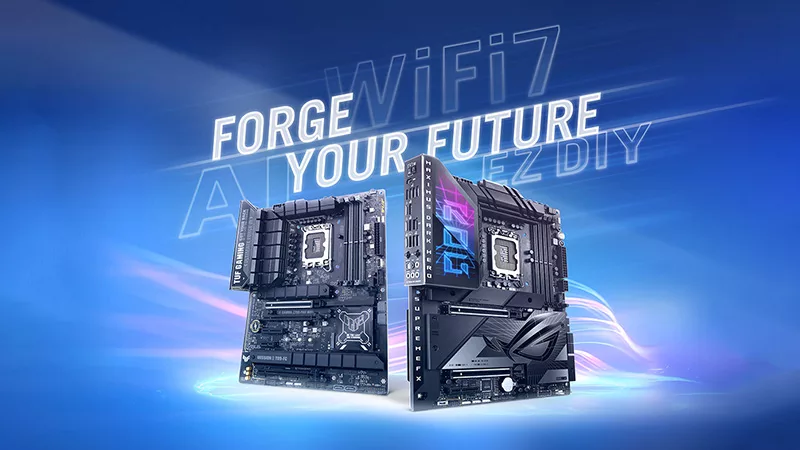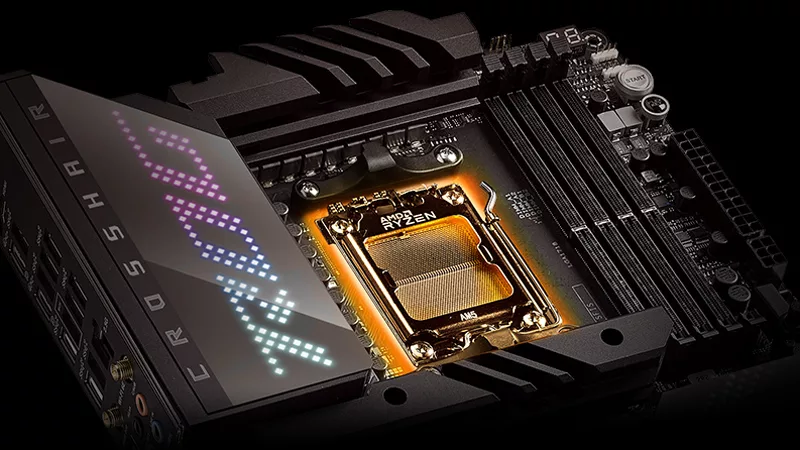Introducing ROG Maximus and Strix Z390 gaming motherboards for 8-core Intel CPUs
With up to eight cores and 16 threads, plus a peak single-core Turbo speed of 5GHz right out of the box, Intel’s new 9th Gen Core CPUs tease a tantalizing combination of raw speed and multithreaded muscle. They’re capable of delivering a great gaming experience even while simultaneously live-streaming and recording, and they’re so powerful that new motherboards are required for the best experience. The Republic of Gamers has a full lineup of compatible Z390 models in multiple sizes.
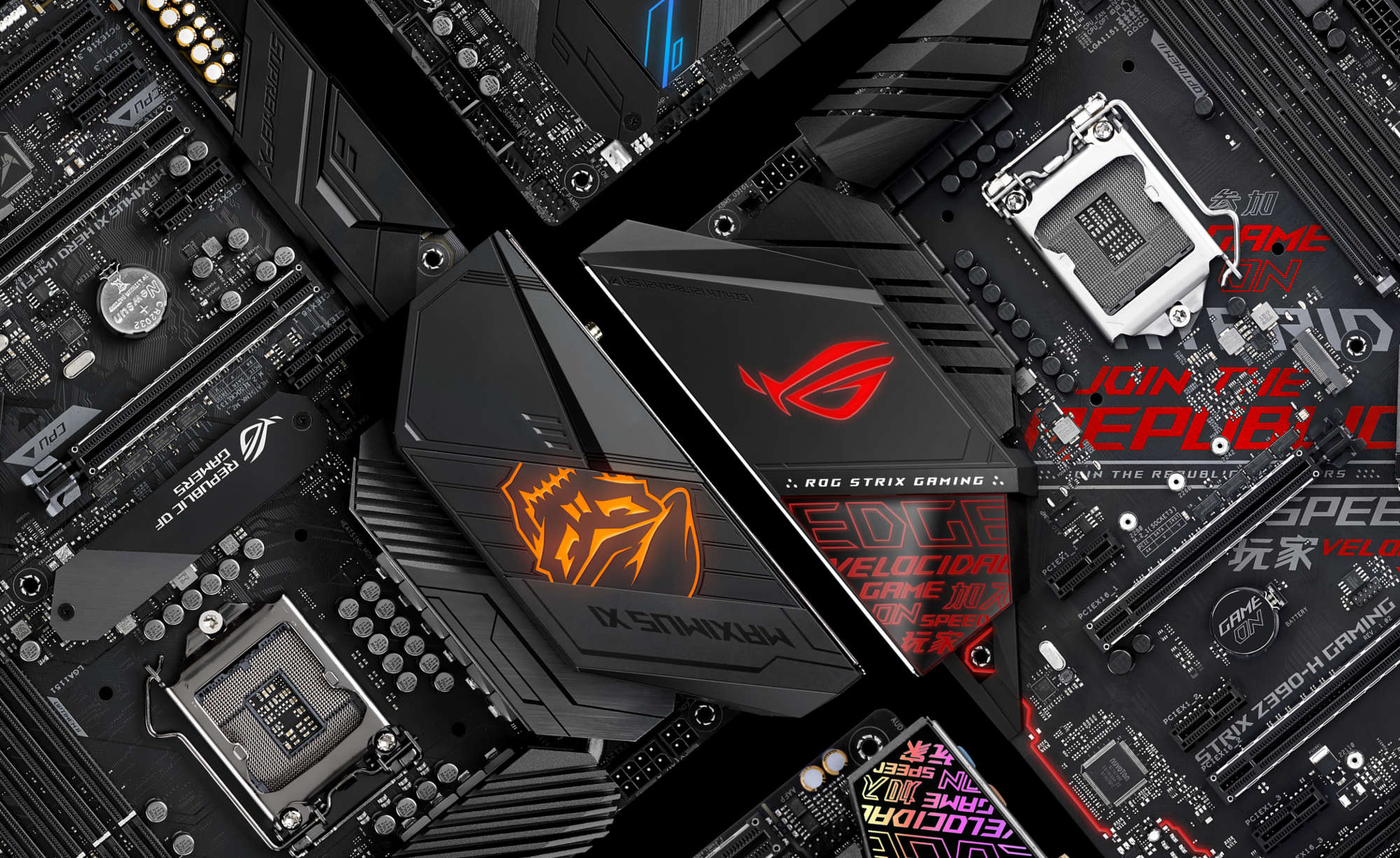
Boards of a feather
The ROG Maximus XI series pushes gaming and overclocking forward with boards carefully tailored for different kinds of builds, from a liquid-cooled masterpiece to a microATX monster. Streamlining in the Strix series brings ROG essentials to more affordable price points and also a smaller Mini-ITX form factor. Before we meet the family, let’s explore its core DNA.
Automated intelligence optimizes performance
The latest generation starts with a trio of unlocked processors ripe for overclocking, and our motherboards have learned new tricks for tapping into their potential. AI Overclocking makes automatic tuning faster and smarter than ever before. Available in Windows or directly through the UEFI, it profiles the CPU and cooling to predict the optimal configuration for each individual system. We created a proprietary algorithm that rates the quality of the silicon to see where your chip lands on the spectrum. The onboard intelligence also watches system vitals like temperatures, fan speeds, and power draw to evaluate cooling performance. Dedicated hardware makes the monitoring seamless, and you can allow continuous training that adapts to upgrades, dust buildup over time, and seasonal changes in ambient temperature. There’s even an adjustable optimism scale that helps to compensate for small variations between chips with the same silicon quality.
AI Overclocking isn’t the only automated solution. Our newest 5-Way Optimization software offers an alternate approach to one-click tuning that simulates a human overclocker by increasing clock speeds, tweaking voltages, and testing stability before pursuing higher frequencies. This technique gets the CPU extremely close to the maximum speed that can be attained with manual tuning, and connected fans can also be calibrated as part of the process. AI Overclocking and 5-Way Optimization are available on all ROG Z390 motherboards except the Strix Z390-H Gaming, which uses predefined profiles to hit higher speeds at the touch of a button. Auto-tuners are perfect for fresh recruits who are new to overclocking, and they provide experts an easy way to quickly assess a system before proceeding with manual tuning.
Eight cores require more power, especially when pushed beyond stock speeds, so our full-sized Z390 boards are beefed up with at least eight power stages for the CPU and one more for the integrated graphics. The heatsinks on higher-end models have the right mix of mass and surface area to effectively absorb and dissipate heat from aggressive overclocks. They extend beyond the MOSFETs and onto the chokes to further improve cooling, and are accompanied by enhanced 8-pin power connectors that use solid pins capable of handling more current than conventional hollow designs. More premium boards use additional phases, larger heatsinks, and more sophisticated circuitry to cope with the power required to push top-of-the-line chips like the Core i9-9900K to their limits.
Memory tweaks increase speed and improve stability
Memory frequencies continue to climb, and our Z390 motherboards have evolved to keep pace. They feature Optimem II, which reimagines memory traces from the ground up—literally. Optimem II adds a dedicated ground plane and surrounding ground trace with via stitching to reduce interference for the traces connecting the CPU and memory slots. It also routes traces through different PCB layers to cut down on crosstalk. These changes combine with our T-Topology trace layout to enable DDR4 speeds in excess of 4266MHz with all slots populated, even if you’re using RGB-infused RAM.
Memory is often to blame if systems fail to boot, so years ago we developed a MemOK! feature that rolls back to safe defaults and adjusts memory parameters to get the system to POST. This failsafe usually has to be activated by pressing a button on the board, but MemOK! II adopts a toggle-based switch that lets you turn it on once. When a memory-related POST problem is detected, MemOK! II automatically applies multiple profiles to bring your system to life.
Smarter cooling for both liquid and air
Our focus on maximizing performance would be futile without similar dedication to improving the cooling that allows systems to sustain faster speeds. The higher power consumption and heat output that comes with additional CPU cores makes liquid cooling a requirement for serious overclocking, so all ROG Z390 motherboards have at least one AIO pump header. The Strix Z390-E and Z390-F Gaming add another header for stand-alone pumps, and ROG goes even further with dedicated sensors for monitoring coolant temperatures and flow rate. The Maximus XI Extreme has a header for custom water blocks, as well, and the Formula features a VRM cooler that can be added to liquid loops.
Fan Xpert 4 manages complete system cooling capable of adapting to any workload. System fans plugged into the motherboard are typically limited to reacting to changes in the CPU or motherboard temperature, which isn’t ideal for gaming and other workloads that heat up the graphics card more than other components. With Fan Xpert 4, the motherboard can react to changes in the GPU temperature on select graphics cards to provide smarter system cooling for a broader range of scenarios.
Configuring the cooling is easy even for first-time builders. Each cooling header adapts automatically to 3-pin DC and 4-pin PWM fans, and the ones reserved for liquid cooling can be retasked for fans. Once everything is plugged in, activating our automated calibration routine profiles the response curve of each connected fan to ensure optimal operation.
Let your Aura Sync shine
RGB lighting has revolutionized how people personalize their PCs, and Aura Sync is the most complete implementation on the market. It synchronizes colors and effects across a diverse cast of system components and peripherals from ROG and our partners, enabling cohesive illumination for your entire battlestation with just a few clicks. Developers can also use the Aura SDK to harness the lighting with their own software; for example, Call of Duty: Black Ops 4 has special Aura effects that enhance immersion by reacting to in-game events and environments.
LED strips are the most efficient way to light up your PC, so all our Z390 motherboards have at least one header with support for up to two meters of lighting. Most models have additional headers, including ones for addressable strips and other devices capable of displaying more advanced effects via independent control over individual LEDs.
A little restraint goes a long way, so we diffuse and reflect the harsh brightness of the onboard LEDs to create a softer and more even glow that blends naturally into each design without being overbearing. Cyber-text patterns on select Strix boards reflect their surroundings to add subtle highlights, and we almost exclusively stick to monochromatic palettes to match with a wide range of components and colors. If you’ve had enough of RGBing All The Things, stealth mode disables the lighting completely for a different look. It even turns off secondary diagnostic LEDs for a complete blackout.
Extensive connectivity inside and out
At least two M.2 slots are available across the board, which gives you the flexibility to run dual NVMe SSDs without connecting any cables. Alternatively, you can install a primary SSD and use the second slot for Intel Optane Memory that accelerates access to a much larger hard drive. All models except for the entry-level Strix Z390-H Gaming have at least one M.2 heatsink to reduce SSD temperatures and ward off thermal throttling with sustained transfers. The ROG Maximus XI Extreme and Maximus XI Gene support up to four M.2 drives, half of which are sandwiched between new heatsinks on our latest DIMM.2 module.
DIMM.2 takes advantage of the Z390 platform’s support for SSD RAID arrays attached to the CPU, which avoids the DMI bottleneck between the processor and chipset. You can also tap into CPU-connected RAID with the ASUS Hyper M.2 X16 Card V2. Up to three SSDs can combine to deliver ludicrous throughput. Arrays are bootable through Intel’s RST framework, making them viable for system drives as well.
Intel Gigabit WiFi is available on select models. The 802.11ac Wave 2 solution connects directly to the chipset via Intel’s CNVi interface. It supports 2x2 MU-MIMO and can push throughput well past 1Gbps on compatible routers like the ROG Rapture GT-AC5300. We use reliable Intel Gigabit Ethernet controllers on every board in the Z390 series, and the ROG Maximus XI Extreme and Maximus XI Formula take networking to the next level by adding Aquantia controllers capable of reaching 5Gbps.
With more USB 3.1 Gen 2 ports available in the Z390 chipset, we can offer additional connectivity for faster devices. All Maximus and higher-end Strix models have front-panel, Type-C, and multiple Type-A ports with double the peak theoretical throughput of their Gen 1 predecessors. The Maximus XI Extreme unlocks even more bandwidth for external devices with a header for the ASUS ThunderboltEX 3 add-in card.
All-new for this generation, the ASUS Node header allows monitoring and control via other devices connected to ROG, Strix Z390-E, and Strix Z390-F. Multiple devices can connect simultaneously, opening up interesting possibilities for DIY gear. We worked with In Win to create a prototype case with an integrated OLED panel that connects via Node and offers both LiveDash functionality and the ability to boot directly to the UEFI, while FSP has created a HydroDPM 1000W PSU that shares power stats, temperatures, and control over the CPU fan.
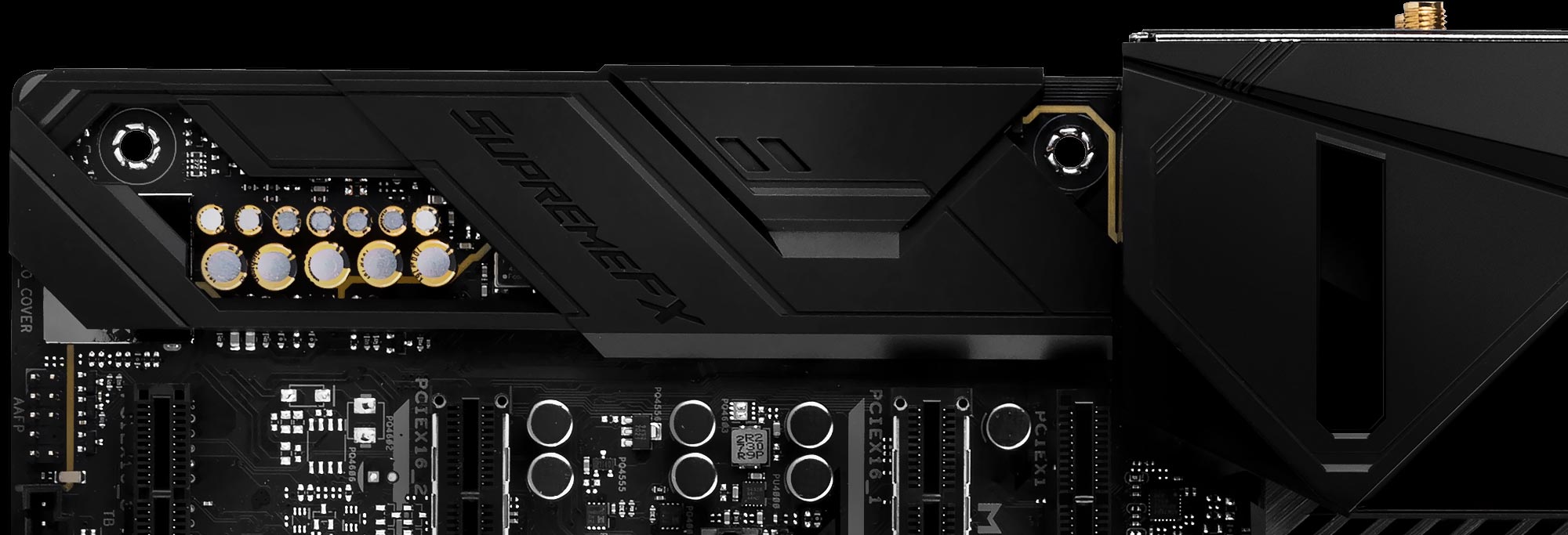
Supreme sound and subtle details
SupremeFX integrated audio is loaded with enhancements, including intelligent amplification that detects the impedance of connected headsets and adjusts automatically to produce the best output. Recording quality receives extra attention, with all boards offering a high 113-dB input SNR that captures crisp communication with squadmates and clear speech for live-streaming. They also share an impressive 120-dB output SNR along with circuitry to reduce popping and cut power-input noise. The hardware is backed by Sonic Studio III software that can inject virtual surround sound and other effects into any device, from analog headphones and USB DACs to VR headsets and even Bluetooth gear.
Each board has a pre-mounted I/O shield for a cleaner look and simpler installation. Even experienced builders occasionally forget to mount this important component before installing the motherboard, but there’s no need to remember when it’s already affixed. You don’t have to navigate the sharp edges and pointy bits of metal that plague traditional shields, either.
The PCIe x16 SafeSlots are secured with extra solder and larger anchoring hooks to hold tightly under the strain of heavy graphics cards. Further reinforcement strengthens the walls, which helps prevent damage if your system is subjected to physical shock. Remember to always buckle up your baby when driving to a local LAN.
More refinement is found inside the UEFI, which offers a streamlined interface for beginners and an advanced mode with more options for experts. Integrated search functionality makes it easy to find the setting you’re seeking within seconds, and any changes are summarized before you exit or save, so you can quickly double-check before pulling the trigger. Anyone can update the latest UEFI with the firmware’s integrated EZ Flash 3 tool, which automatically downloads and installs the right BIOS for your board.
Our new Armoury Crate utility combines useful functions for multiple ASUS products in a single UWP app. Introduced this summer with new ROG laptops, Armoury Crate is expanding into Z390 motherboards and other components, and it continues to add features to its arsenal. Optical drives are rare in new gaming PCs, so our Q-Installer software lets you download all of the latest drivers and utilities for your board with a single click, or select only the ones you want.
Maximus your Z390 motherboard
For the latest generation, our Maximus XI series embraces the dark side with blacked-out boards in multiple sizes and variations. It leads with the unparalleled Maximus XI Extreme for dream builds, which is followed by armour-clad near twins in Maximus XI Formula and Code. The Maximus XI Apex reprises its role as a premiere overclocking platform for LN2 junkies, the Maximus XI Gene rethinks our approach to microATX, and the Maximus XI Hero strikes the right balance in three different flavors.
| Maximus XI Extreme | Maximus XI Formula | Maximus XI Code | Maximus XI Apex | Maximus XI Hero (Wi-Fi) | Maximus XI Gene | |
|---|---|---|---|---|---|---|
| Size | EATX | ATX | ATX | ATX | ATX | microATX |
| Memory | 4 x DDR4 up to 4400+ (OC) | 4 x DDR4 up to 4400+ (OC) | 4 x DDR4 up to 4400+ (OC) | 4 x DDR4 up to 4600+ (OC) | 4 x DDR4 up to 4400+ (OC) | 2 x DDR4 up to 4600+ (OC) |
| Multi-GPU | 2 SLI, 3 CrossFireX | 2 SLI, 3 CrossFireX | 2 SLI, 3 CrossFireX | 2 SLI, 3 CrossFireX | 2 SLI, 3 CrossFireX | NA |
| PCIe | 3 x16 1 x1 |
3 x16 1 x1 |
3 x16 1 x1 |
3 x16 1 x1 |
3 x16 3 x1 |
1 x16 |
| M.2 | 4 x4 | 2 x4 | 2 x4 | 2 x4 | 2 x4 | 4 x4 |
| SATA | 6 | 6 | 6 | 6 | 6 | 4 |
| Ethernet | Aquantia 5G Intel 1G |
Aquantia 5G Intel 1G |
Intel 1G | Intel 1G | Intel 1G | Intel 1G |
| WiFi | 802.11ac | 802.11ac | 802.11ac | 802.11ac | Optional | 802.11ac |
| Audio | SupremeFX S1220 | SupremeFX S1220 | SupremeFX S1220 | SupremeFX S1220 | SupremeFX S1220 | SupremeFX S1220 |
| USB 3.1 Gen2 | 1 front 1 Type-C 3 Type-A |
1 front 1 Type-C 3 Type-A |
1 front 1 Type-C 3 Type-A |
1 front 1 Type-C 3 Type-A |
1 front 1 Type-C 3 Type-A |
1 front 1 Type-C 3 Type-A |
| RGB Headers | 2 strip 2 address |
2 strip 2 address |
2 strip 2 address |
1 strip 1 address |
2 strip 2 address |
2 strip |
| Price | $599.99 USD $779.99 CAD |
$449.99 USD $584.99 CAD |
$349.99 USD $454.99 CAD |
NA | $289.99 USD $376.99 CAD |
NA |
| Availability (USA) | Newegg Amazon |
Newegg | NA | Newegg Amazon |
NA | |
| Availability (Canada) | Canada Computers | Memory Express Canada Computers |
NA | Memory Express Canada Computers |
NA |
Build your dream with the Maximus XI Extreme
The Maximus XI Extreme is indulgent without being frivolous. As the flagship, it walks the line between achieving peak performance and providing the extra features that make showcase builds stand out.
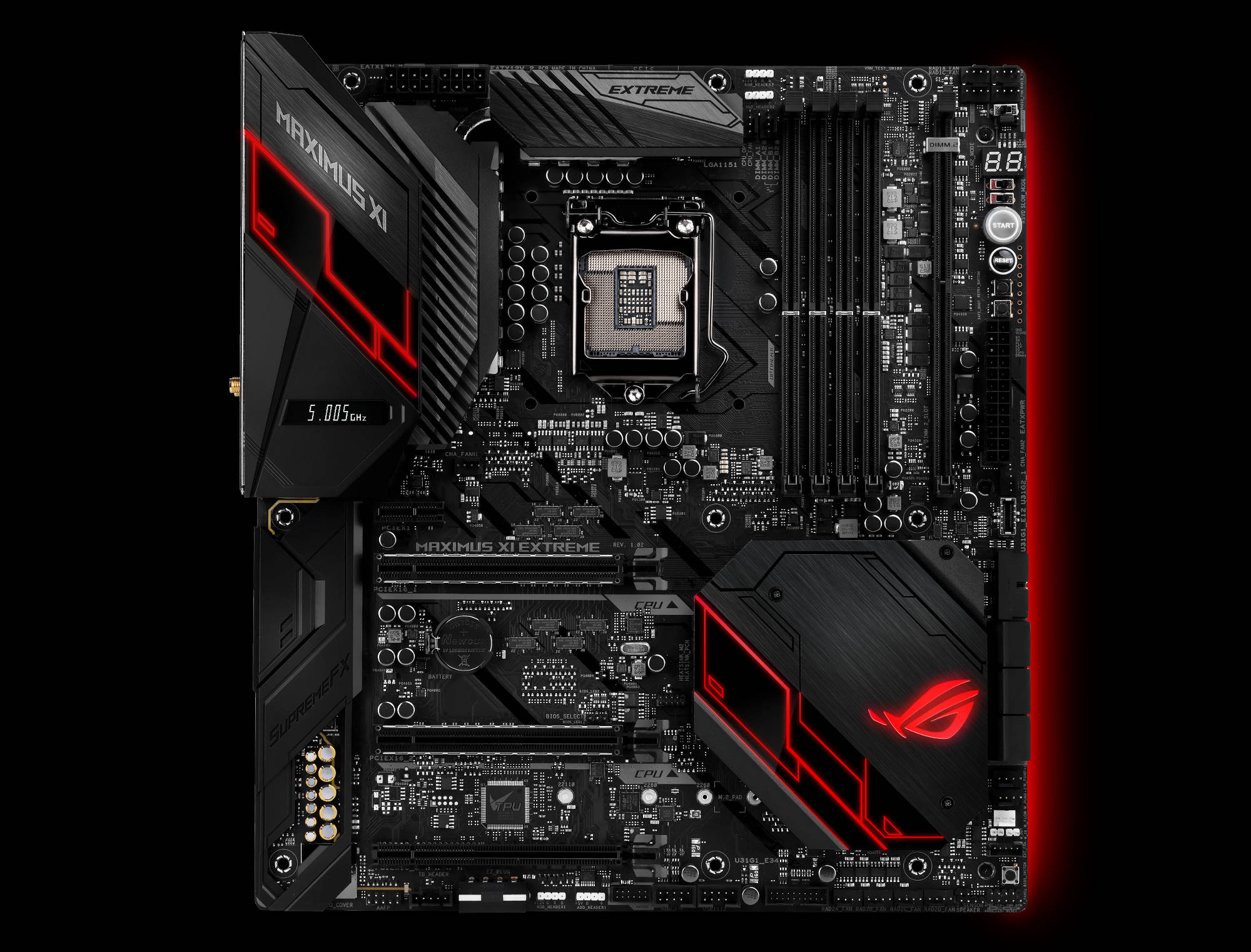
Subtle upgrades for hardcore overclocking are found throughout the board. Dual 8-pin power connectors are capable of delivering more 12V power directly to the CPU, and we’ve adjusted the phase configuration to better distribute the heavier load presented by eight overclocked cores. Serious overclockers can monitor voltages directly with a multimeter using ProbeIt points on the PCB, and there’s a special LN2 mode for sub-zero record attempts.
If you’re building an actual rig, custom liquid loops are basically a requirement at this end of the spectrum, so the Extreme has a special connector just for water blocks. With a single cable, block makers can let the motherboard track flow rates, coolant temperatures, and leak-detection circuits. This augments the separate flow and temperature headers, allowing monitoring at multiple points or for an entirely separate loop.
With 16 pump and fan headers, the Extreme is equipped to manage even the most elaborate system cooling with a single powerful interface. There are two onboard pump headers, 12 for fans, and four more via the Fan Extension card included in the box. The headers are also carefully grouped and organized. The liquid zone in the bottom right corner matches typical reservoir locations; two clusters of four fan headers are positioned within reach of beefy radiators at the top, front, and bottom of the chassis; and the rest distributed near typical system fan locations.
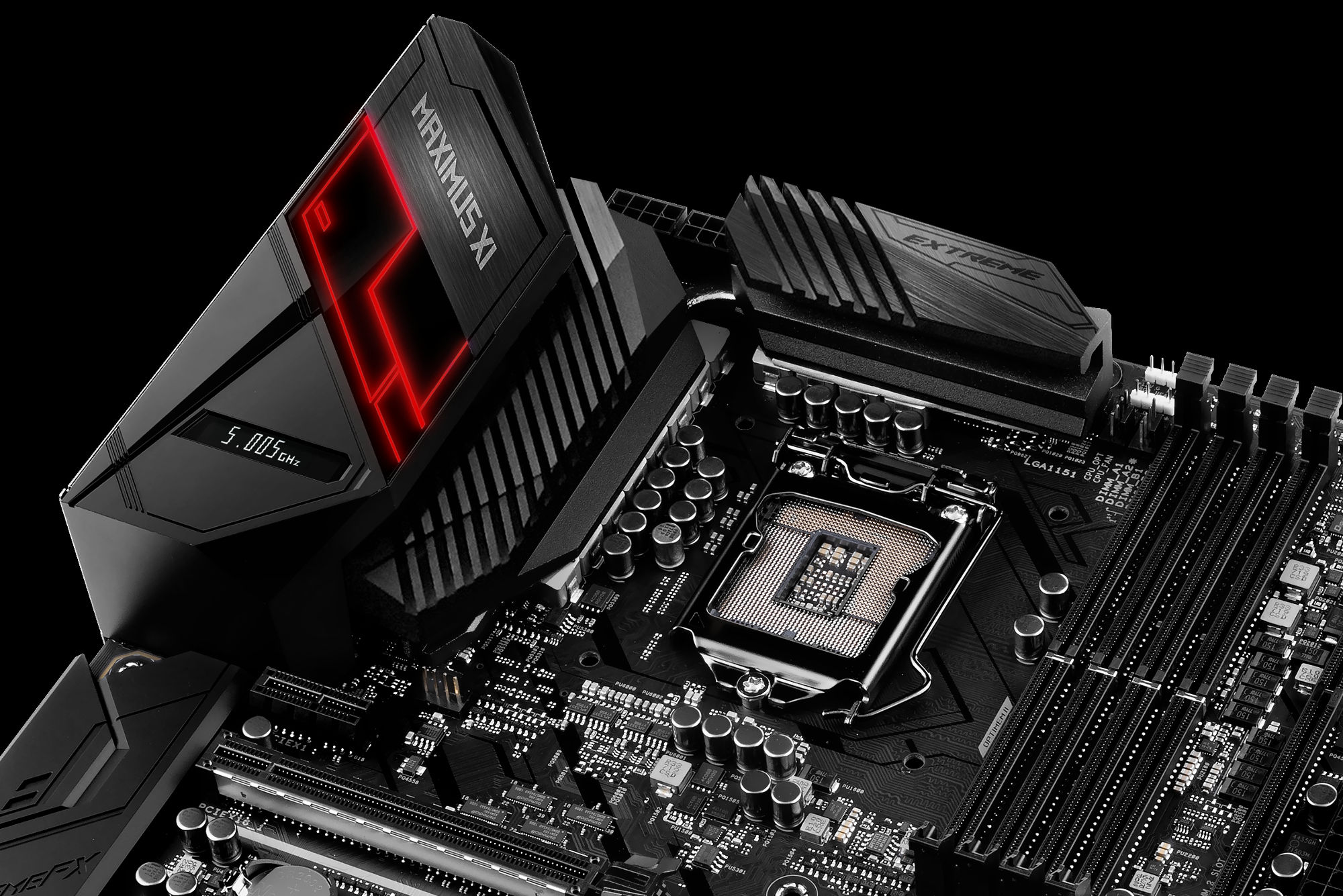
While the Extreme arguably looks most striking in stealth mode, where its Vader aesthetic takes center stage, you can still light it up with a fistful of RGB strips. The LiveDash OLED embedded in the I/O cover adds a subtle display for keeping tabs on system vitals or displaying simple text, images, and animations that enable even more customization.
Between the two-slot DIMM.2 module connected directly to the CPU and the pair of M.2 slots hanging off the chipset, the Maximus XI Extreme can cleanly run up to four NVMe SSDs without any wires or drive bays. The spec sheet is stacked with standouts, including wicked-fast 5G wired networking and gigabit-class Intel WiFi. We also added an auxiliary controller to provide even more USB 3.1 Gen 2 ports.
One Maximus to rule the rest, the new Extreme raises the stakes for premium Z390 motherboards. Priced at $599.99 USD and $779.99 CAD, the Maximus XI Extreme will be available for pre-order soon.
Choose between the liquid-ready Maximus XI Formula and streamlined Maximus XI Code
Fraternal twins based on the same foundation, the Maximus XI Formula and Maximus XI Code have distinctly different missions. The Formula is plumbed for custom liquid cooling and includes other enhancements to punctuate premium systems, while the Code takes a more straightforward approach that extends from the spec to the armored exterior.
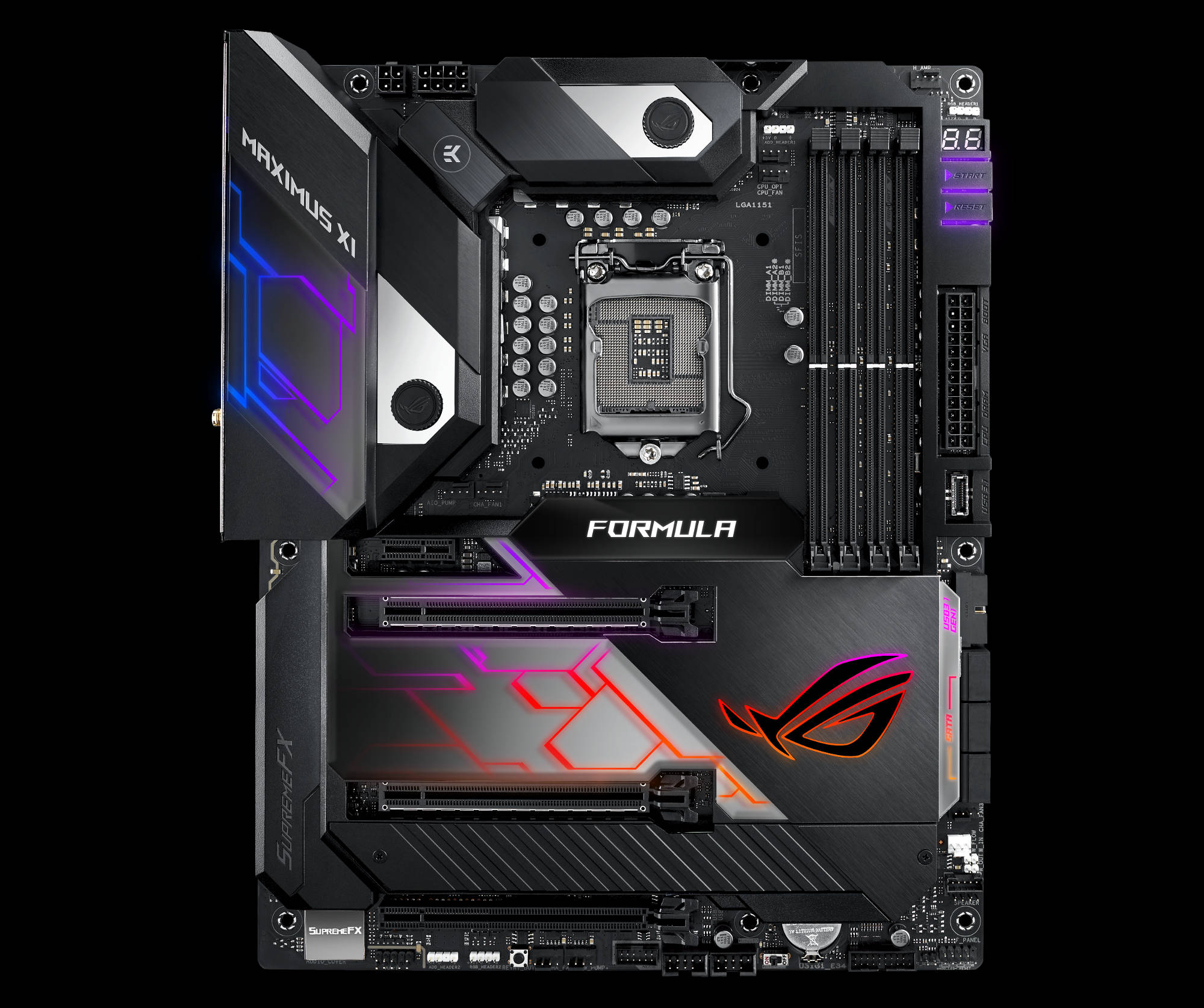
We collaborated with the experts at EK Water Blocks to create the CrossChill EK III VRM block for the new Formula. Designed for the higher VRM load associated with eight-core CPUs, the block has a wider internal channel and more copper to improve thermal dissipation. It’s compatible with standard fittings to simplify integration with the rest of your loop and nicely complements the coolant flow and temperature sensors available on the board.
The Formula advances customizable aesthetics with intricate patterns cut into its reflective armor, plus illuminated labels for SATA and front-panel USB ports. A larger LiveDash OLED sits in prime view below the socket and boasts a 256x64 resolution that offers more room for monitoring system stats and showing your own graphics and messages. It’s part of a broader effort to bring useful displays to more of our devices, including the ROG Thor PSU and Ryuo and Ryujin liquid coolers.
Wired networking gets a substantial boost from the Formula’s Aquantia 5G Ethernet controller, which is the same chip used on the Extreme. This is the only key spec where Code differs. Both boards are based on the same PCB and otherwise share identical layouts and connectivity. They’re fully loaded with onboard WiFi, dual M.2 slots covered by heatsinks, and loads of USB ports poking through integrated I/O shields.
Despite lacking the CrossChill EK III VRM block, the Code still has temperature and flow headers for liquid loops along with separate connectors for an all-in-one cooler and dedicated pump. With six additional fan headers, including one capable of pushing high-amperage spinners, both have ample capacity for complete system cooling.
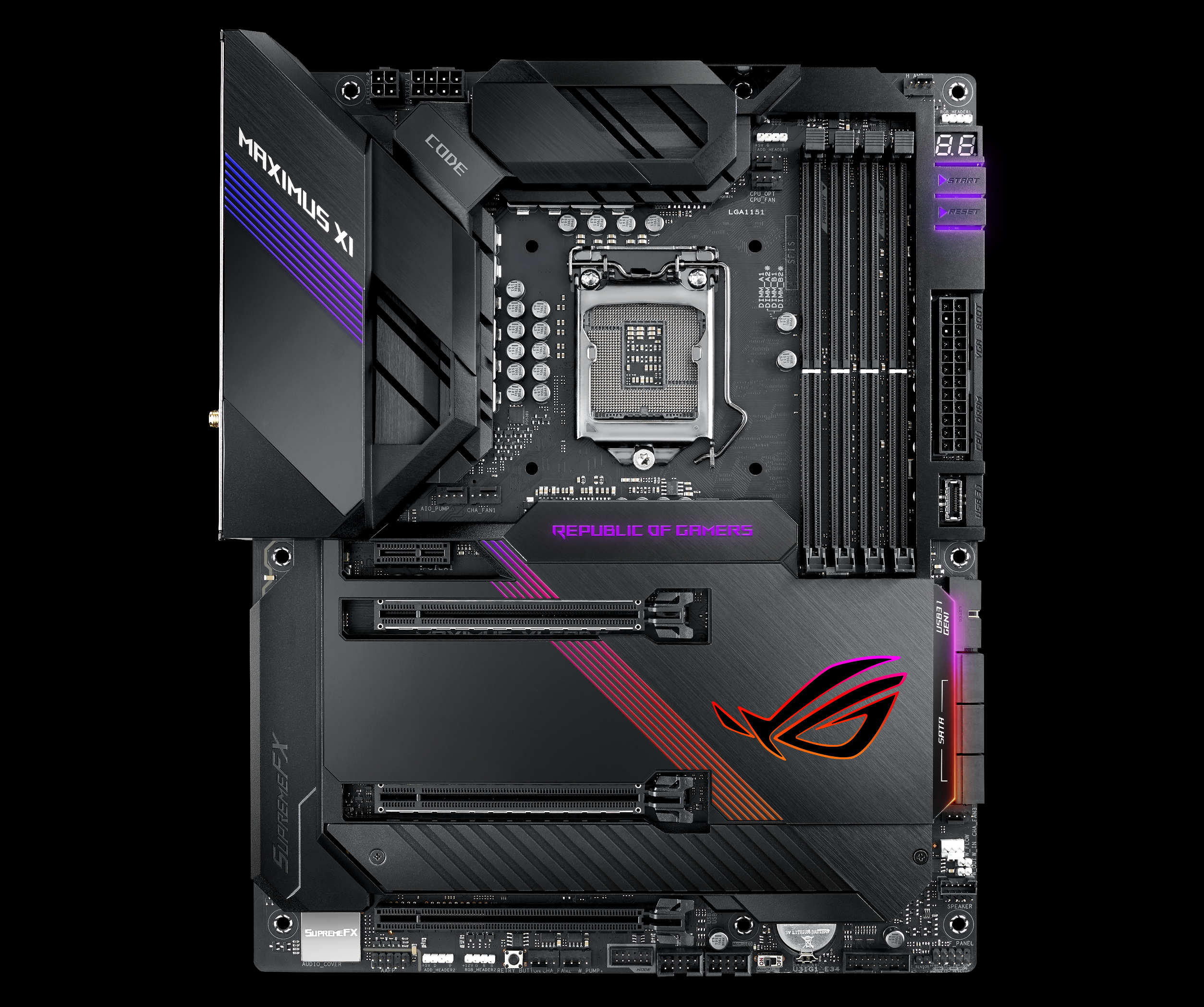
Subtler armour blankets the Code’s exterior to protect the PCB and give builds a cleaner overall look. The board is better for streamlined systems that eschew the extravagances found in typical Formula builds, and the price tag is lower as a result. The Maximus XI Code is available for pre-order at the retailers above for $349.99 USD and $454.99 CAD, while the Maximus XI Formula pushes the price to $449.99 USD and $584.99 CAD.
Break overclocking records with the Maximus XI Apex
All of ROG’s Z390 motherboards are made for overclocking, but none quite like the Maximus XI Apex. This board isn’t just for taking clocks beyond stock speeds; it’s purpose-built to push them higher than ever before. Since it was first introduced two generations ago, the Apex series has claimed frequency and benchmark records on Z270, X299, and Z370 platforms. Now, it’s poised to take on Intel’s first eight-core desktop CPU.
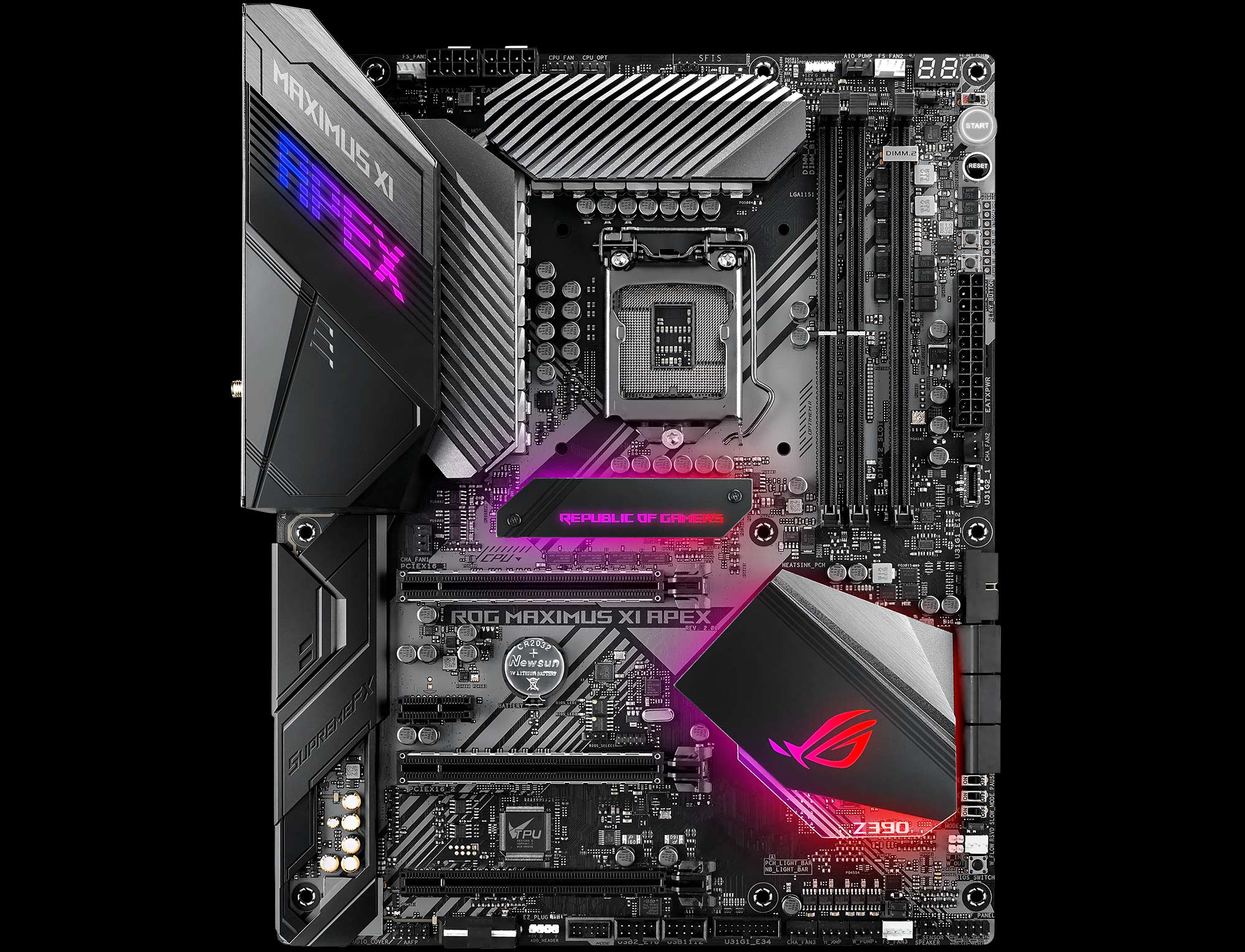
Good CPUs can reach extraordinary frequencies when chilled to sub-zero temperatures, but they demand a lot of stable power. The Apex delivers with an upgraded VRM design fed by dual eight-pin auxiliary power connectors. There are more phases than on even the Extreme, which is a testament to what it takes to eke out the last few MHz at the limits of the silicon.
Running at sub-zero temperatures is required to reach the top of the leaderboards, so the Apex has special operating modes for LN2 junkies. Elite overclockers are known for meticulously insulating their boards to deal with the resulting condensation. That part is still up to you, but we add a condensation detection circuit that can provide a warning if your defenses are breached. ProbeIt points are also available for closely monitoring vital voltages with a multimeter.
With 10 fan headers, the onboard cooling has enough capacity for more specialization. Three headers are locked at full speed and meant for blowing away the vapor that billows from LN2 pots. Two are configured for liquid cooling at conventional temperatures, and they’re joined by headers for monitoring the flow and temperature in custom loops.
Having one DIMM per memory channel makes the traces to the CPU more direct, which enables higher frequencies. With the right modules, you can overclock up to DDR4-4600 and beyond. This configuration limits total memory capacity to 32GB with standard modules, so we developed Double Capacity DRAM that essentially puts two DIMMs on a single, taller stick. G.Skill and Zadak are prepping compatible kits that will allow you to install 64GB of RAM on the Apex and other dual-slot boards in the Maximus XI series.
Doubling up is a consistent theme. Next to the memory sits a DIMM.2 module with two M.2 slots sandwiched by a passive heatsink. There are also dual PCIe x16 slots to the south for two-way SLI and CrossFireX. Support for four graphics cards is required to be competitive in some benchmarks, but the Rampage VI Apex is better-equipped for that mission thanks to the greater PCIe bandwidth available through its X299 platform and Skylake-X CPU.
Although it’s very much built for life on the edge, the Maximus XI Apex still has creature comforts for everyday builds, such as extensive connectivity, fast WiFi, and tasteful onboard lighting. It will be available later this year; look for it on the HWBot leaderboards.
The Maximus XI Gene offers a new approach to microATX
The Gene is back with the Maximus XI family, this time with a twist. Multi-GPU configurations are becoming rarer as NVIDIA and AMD focus on single-card performance, and GPU coolers are growing beyond two slots to improve performance and reduce noise. The old Gene’s dual-GPU focus doesn’t reflect the kinds of systems gamers and enthusiasts are building, so the new model refocuses to aggressively pursue higher performance and support additional storage. It has already made its mark on the hardware leaderboards by claiming 11 global first place scores and eight world records, including the fastest CPU frequency at 7613.19MHz and the highest memory clock at 5566MHz.
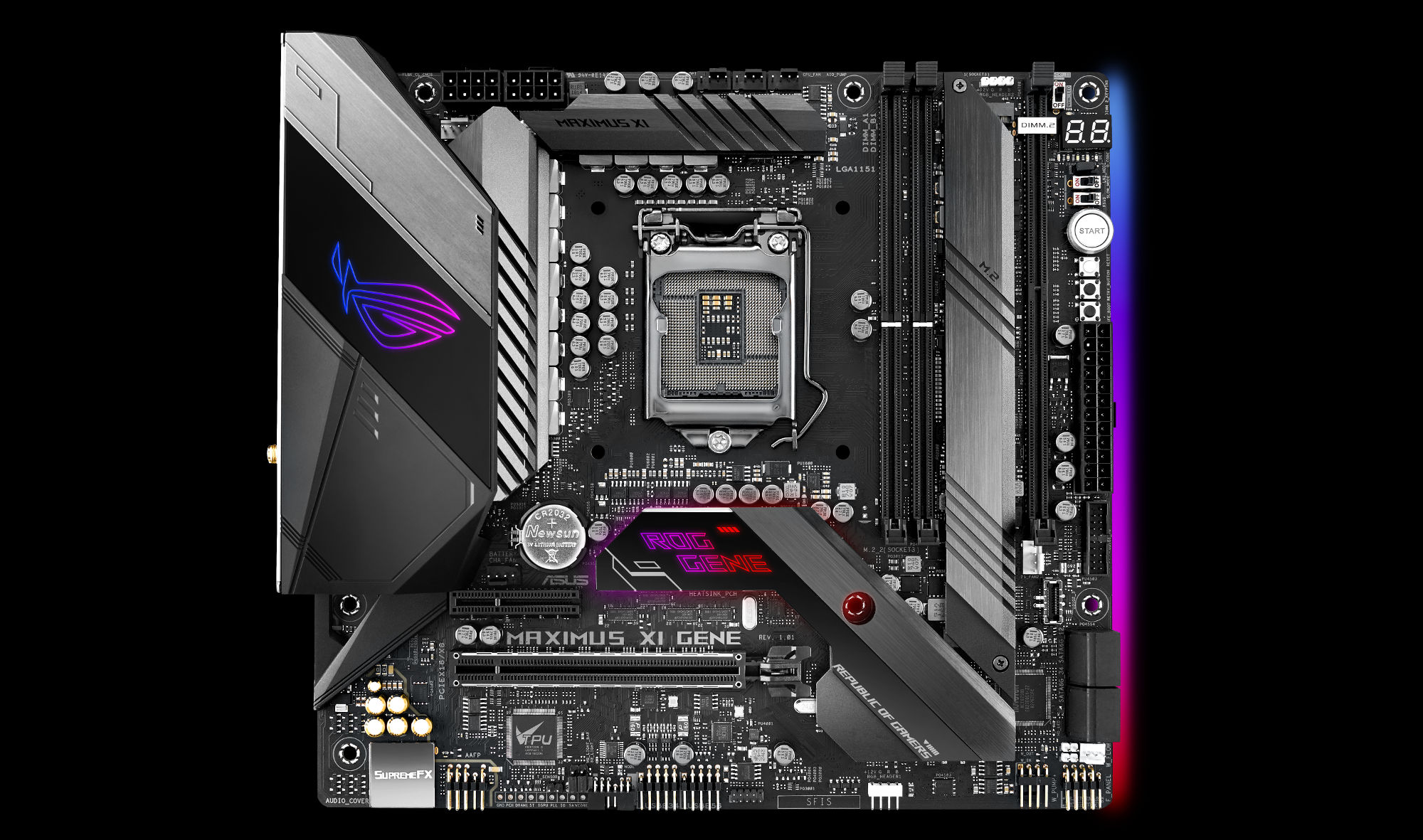
With the same dual 12V CPU power connectors and rebalanced VRM as the Extreme, the Maximus XI Gene effortlessly powers eight-core processors pushed to the very limit. Its substantial VRM heatsinks help to compensate for the reduced airflow typically found in more compact systems. The Gene includes an LN2 mode for record-setting benchmark runs and ProbeIt points to closely monitor voltages when you’re on the edge. You also get dual high-speed fan headers for blowing smoke and enough standard cooling connectors for a collection of fans and liquid components.
We switched to dual DIMM slots to enable higher memory frequencies, allowing the board to support modules running at up to DDR4-4533 and higher. Double Capacity DRAM support ensures you can still run 64GB, providing the versatility to seek maximum speed or capacity. Look for new G.Skill TridentZ RGB DC and Zadak Shield DC Aura2 kits to double up on DRAM.
Removing two DIMM slots leaves room for a DIMM.2 module with integrated heatsinks for two NVMe SSDs connected to the CPU. There are slots for two more M.2 drives under a heatsink between the memory and DIMM.2 slots, putting all your high-speed storage and memory in the same region for easy cooling. You can load up on SSDs without cluttering your build and combine all four in a bootable NVMe RAID array with phenomenal speed and capacity.
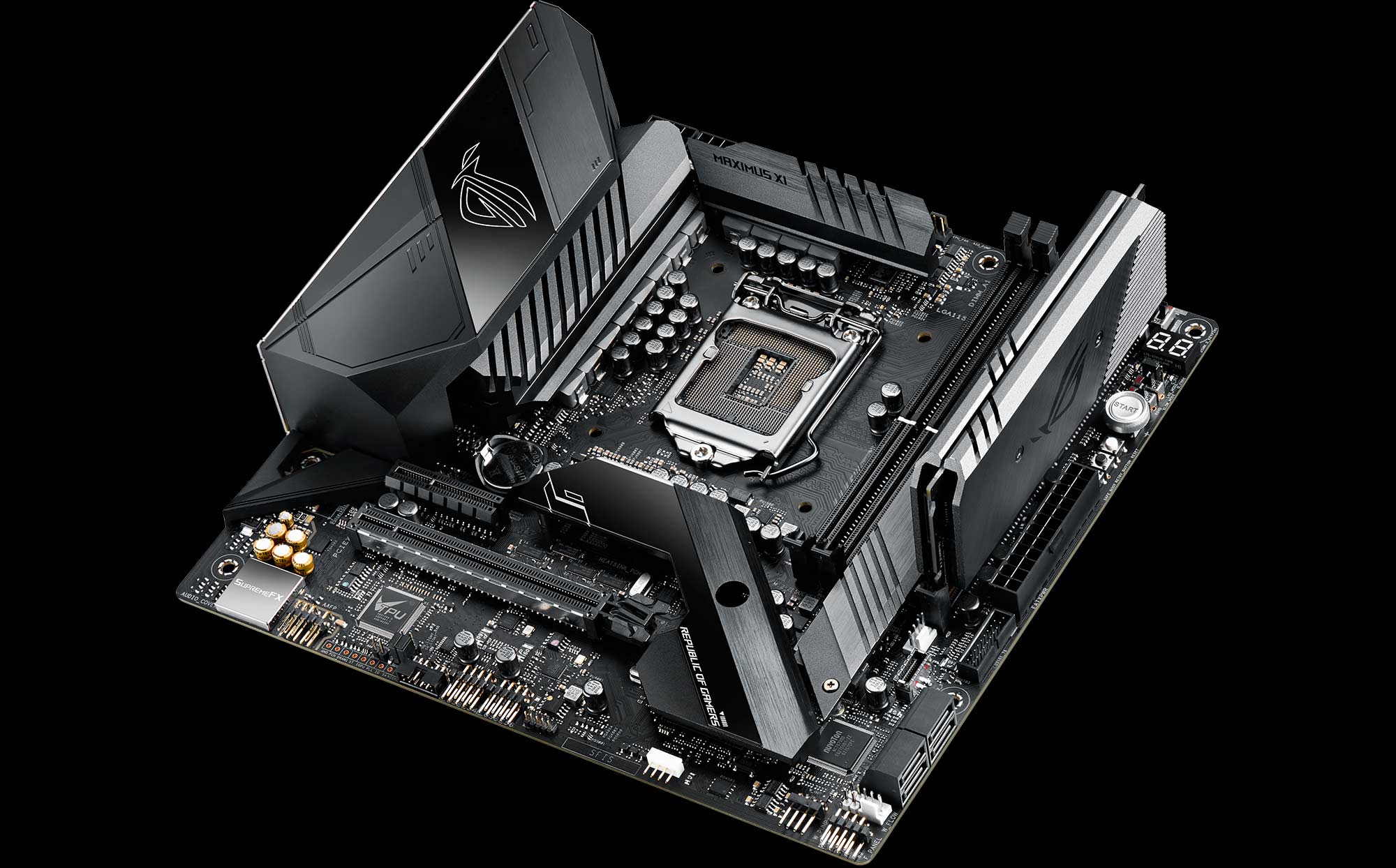
Although it has a similar footprint to conventional microATX boards, the Maximus XI Gene is anything but. From little hints like the edge-facing connectors at the bottom, to more obvious features like the substantial VRM and M.2 heatsinks, the board charts a new course for microATX. Check with your local ASUS ROG representative for details about availability in your region.
Choose your own Maximus XI Hero
As the gatekeeper for the family, the Maximus XI Hero has to strike a more delicate balance than the rest of the series. We constantly reevaluate the spec to ensure that the board delivers the right mix of our latest features in a complete package that’s unmistakably ROG.
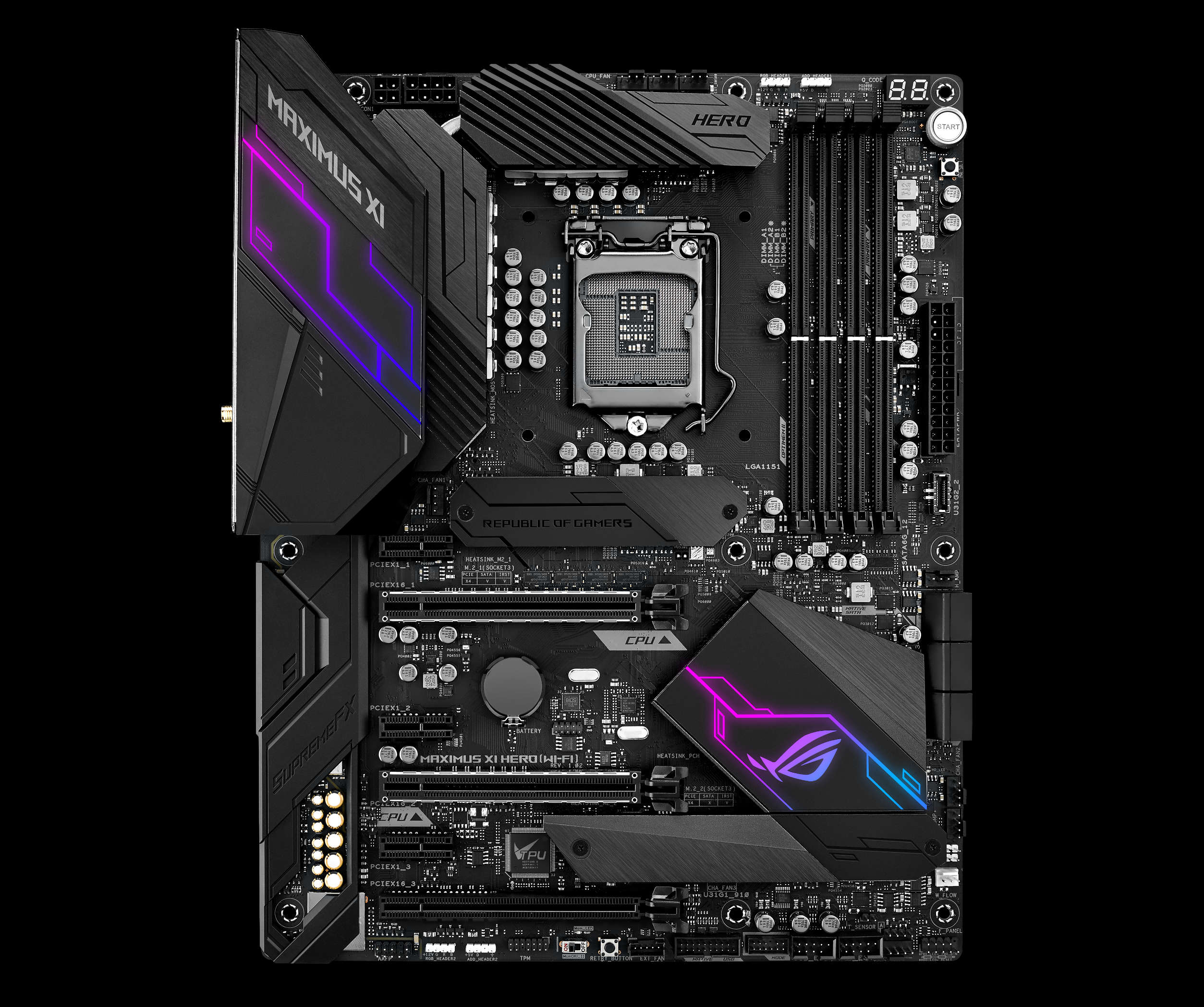
Back in black for a new generation, the Maximus XI Hero embodies ROG’s murdered-out motif down to the little details on the PCB, like neutral slots, headers, and switches. The monochromatic shades and angular lines arguably look best in stealth mode, with every onboard LED dark, but you can still light up patterns on the I/O cover and PCH in addition to driving multiple standard and addressable RGB strips.
Silk-screened labels on the PCB clearly identify key features for inexperienced builders, like the CPU-connected PCIe slots for graphics cards, and the primary DRAM slots that need to be populated for a dual-channel memory config—you wouldn’t want to miss those! These helpful highlights can be found on other Maximus models, as well.
To provide additional headroom for overclocked CPUs, the Hero adds a second 12V power connector and substantial VRM heatsinks. There’s plenty of cooling connectivity onboard, including headers for multiple pumps, up to six fans, and sensors that monitor coolant flow and temperatures. SSD cooling is covered by an M.2 heatsink affixed to each of the two onboard slots.
The integrated I/O shield has quickly become a staple of ROG motherboards, and it’s packed on the Hero. You get loads of USB ports for all your gear, including multiple VR trackers and game controllers. One port works with USB BIOS Flashback, another ROG staple that can update the UEFI using just a thumb drive and power supply, with no CPU or other components required. Intel Gigabit Ethernet is standard equipment, with comparable WiFi available on a second version of the board with integrated wireless.
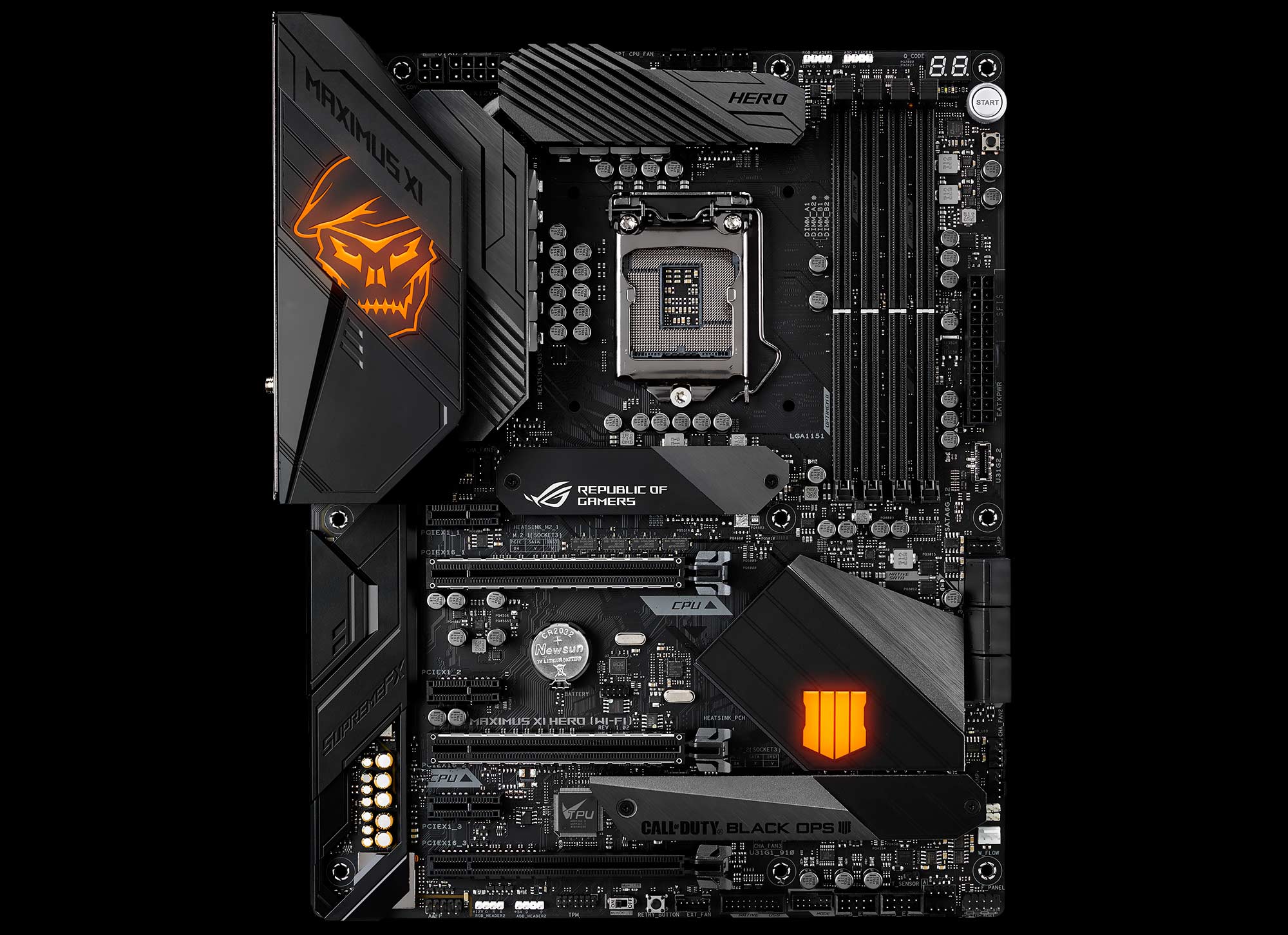
A third version of the Hero celebrates ROG’s collaboration with Call of Duty. Instead of the usual onboard lighting, the Maximus XI Hero (Wi-Fi) Call of Duty: Black Ops 4 Edition illuminates the FPS franchise’s recognizable skull and BO4 icon, plus a different look for the PCH and M.2 heatsinks. The board shares styling with the other hardware in our Black Ops 4 collection, so you can put together a matching rig that combines ROG and COD.
The ROG Maximus XI Hero (Wi-Fi) rings in at an attainable $289.99 USD and $376.99 CAD, and pricing for the exclusive Black Ops 4 Edition will be announced soon. Check the pre-order links above to reserve yours now, and ask your local ASUS ROG rep if you’re interested in the wireless Hero.
Democratizing the republic with ROG Strix
ROG Strix fills the space below the Maximus series with more affordable options that retain the look and feel people have come to expect from the Republic of Gamers. These models keep must-have features for gaming and overclocking but steer clear of more luxurious extras that add significant cost. In the Z390 series, the Mini-ITX Strix Z390-I Gaming is joined by three full-sized ATX boards: the Strix Z390-E, Z390-F, and Z390-H Gaming.
| ROG Strix Z390-E Gaming | Strix Z390-F Gaming | Strix Z390-I Gaming | Strix Z390-H Gaming | |
|---|---|---|---|---|
| Size | ATX | ATX | Mini-ITX | ATX |
| Memory | 4 x DDR4 up to 4266+ (OC) | 4 x DDR4 up to 4266+ (OC) | 2 x DDR4 up to 4600+ (OC) | 4 x DDR4 up to 4266+ (OC) |
| Multi-GPU | 2 SLI, 3 CrossFireX | 2 SLI, 3 CrossFireX | NA | 2 SLI, 3 CrossFireX |
| PCIe | 3 x16 3 x1 |
3 x16 3 x1 |
1 x16 | 3 x16 3 x1 |
| M.2 | 2 x4 | 2 x4 | 2 x4 | 2 x4 |
| SATA | 6 | 6 | 4 | 6 |
| Ethernet | Intel 1G | Intel 1G | Intel 1G | Intel 1G |
| WiFi | 802.11ac | NA | 802.11ac | NA |
| Audio | SupremeFX S1220 | SupremeFX S1220 | SupremeFX S1220 | SupremeFX S1220 |
| USB 3.1 Gen2 | 1 front 1 Type-C 3 Type-A |
1 Type-C 3 Type-A |
1 front 2 Type-A |
4 Type-A |
| RGB Headers | 2 strip 1 address |
2 strip 1 address |
1 strip 1 address |
1 strip |
| Price | $244.99 USD $318.99 CAD |
NA | $209.99 USD $272.99 CAD |
$189.99 USD $246.99 CAD |
| Availability (USA) | Newegg Amazon Micro Center |
NA | Newegg Amazon |
Newegg Amazon |
| Availability (Canada) | Memory Express Canada Computers |
NA | Memory Express Canada Computers |
Memory Express Canada Computers |
The Strix Z390-I Gaming is compact without compromise
Mini-ITX systems don’t need to give up power to fit into small form factors. The ROG Strix Z390-I Gaming is designed to push your CPU and memory well beyond stock speeds within the confines of a tiny 6.7” x 6.7” footprint.
Limited real estate forces a few unavoidable concessions, but we can compensate or even exploit them to our advantage. Having only two DIMM slots makes the traces more direct, which enables faster memory speeds than four-slot boards that are optimized to run fully loaded. With the right modules, you can hit up to DDR4-4600 speeds. Fewer slots would normally limit memory capacity as well, but support for Double Capacity DIMMs makes 64GB of RAM an option for Mini-ITX builds.
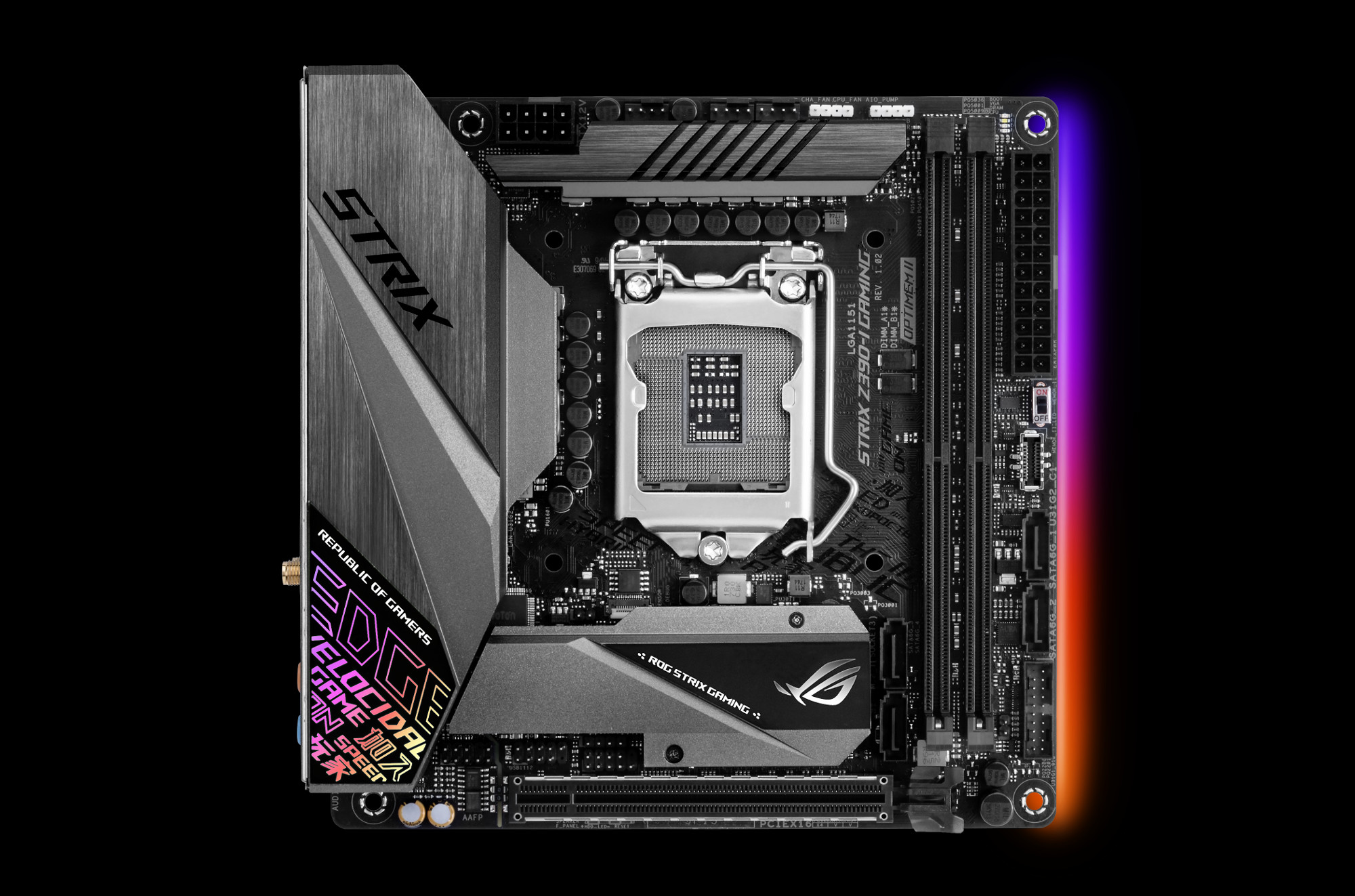
Smaller boards leave less room for cooling, so we combined the I/O cover with one of the VRM heatsinks to increase the surface area for thermal dissipation. The metal cover adds a more premium feel in addition to improving cooling. It isn’t the only multipurpose cooling component, either. The chipset heatsink is a double-decker design that also cools SSDs installed in the primary M.2 slot. A second M.2 slot is tucked underneath the board, allowing you to run dual drives without cluttering your chassis with SATA cables.
With fewer expansion options, the Strix Z390-I Gaming incorporates more of what you need right out of the box. The HDMI 2.0 output supports 4K displays at 60Hz, so you can connect a big-screen TV without even installing a graphics card. Intel Gigabit WiFi eliminates the need to run Ethernet cable to your home theater, and Bluetooth 5.0 is great for connecting peripherals from across the room on the couch.
Aura Sync lights up the right edge and powers standard and addressable RGB headers that can give off more than enough light for Mini-ITX rigs. A trio of headers for cooling lines up along the top of the board, where wiring can easily be tucked around the edge.
The ROG Strix Z390-I Gaming is versatile enough for a range of Mini-ITX builds, like compact home-theater PCs, portable rigs for LAN parties, and diminutive desktops that mix work and play. It’s available from the retailers listed above for $209.99 USD and $272.99 CAD.
Family values define the ROG Strix Z390-E and Z390-F Gaming
For full-sized systems, the Strix Z390-E and Z390-F Gaming offer similar specs with a few key differences. Their shared features highlight the values behind ROG Strix, starting with predominantly black designs that can slip into stealth mode when you’ve had enough of RGB lighting.
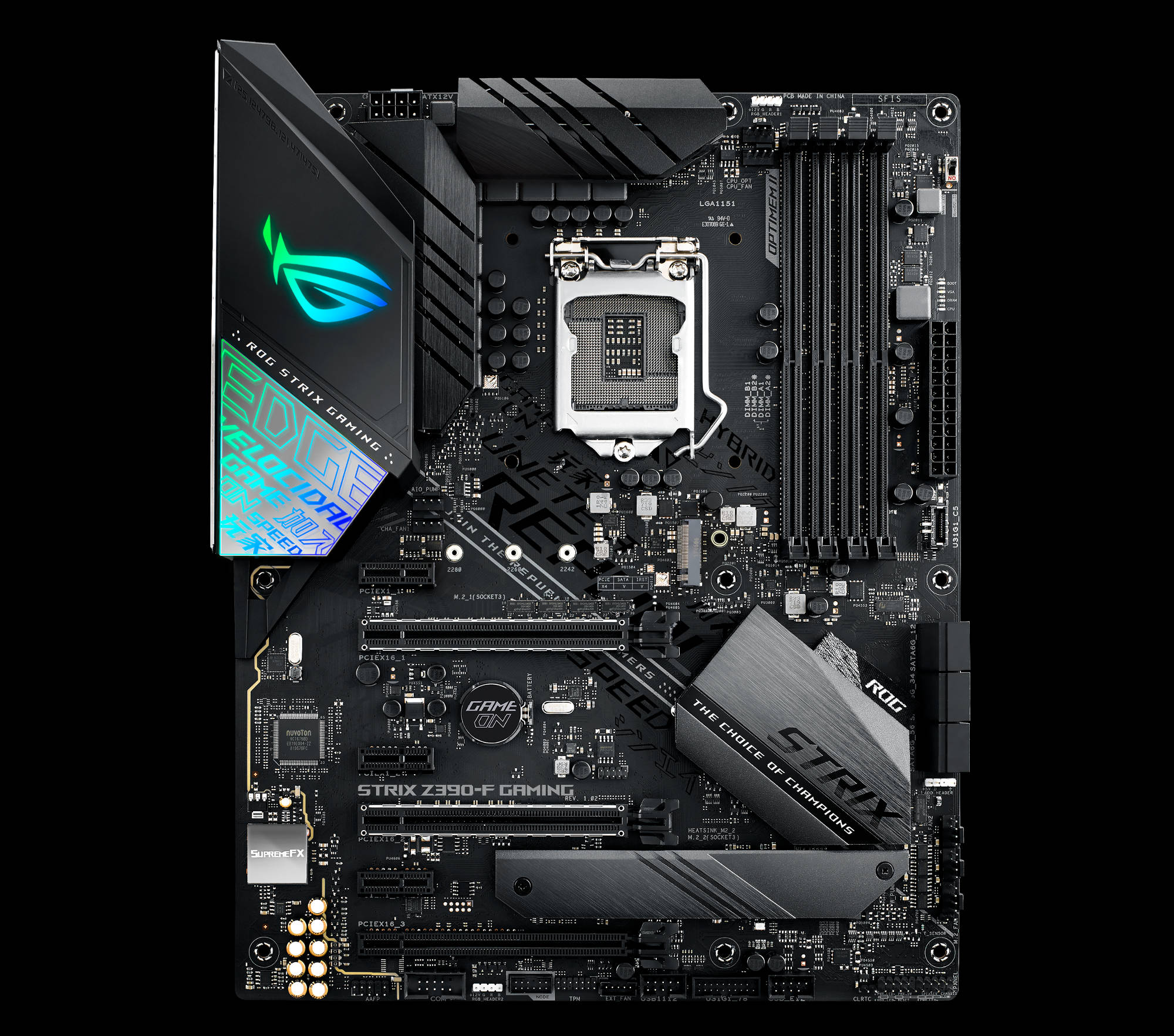
Distinctive cyber-text patterns slash across not only the board, but also a vinyl surface on the I/O shroud that reflects ambient light. The boards generate illumination of their own with backlit ROG logos on the shroud. Between dual headers for conventional RGB strips and one for addressable hardware, they also have the ability to light up an entire machine with an Aura Sync glow inside and out.
These are the only Strix boards with ROG’s new Node connector for external devices. The bidirectional link can send signals in both directions, which allows interesting possibilities beyond the basic hardware monitoring functions that dominate the first compatible components.
The Strix Z390-E and Z390-F both support memory speeds up to DDR4-4266 across four-DIMM configurations. They have dual M.2 slots, although only the Z390-E offers heatsinks for each one. That board also features an auxiliary bracket for mounting a fan that blows air directly over the VRM heatsinks. Both boards have the same number of cooling headers neatly grouped in key areas for cleaner cable routing.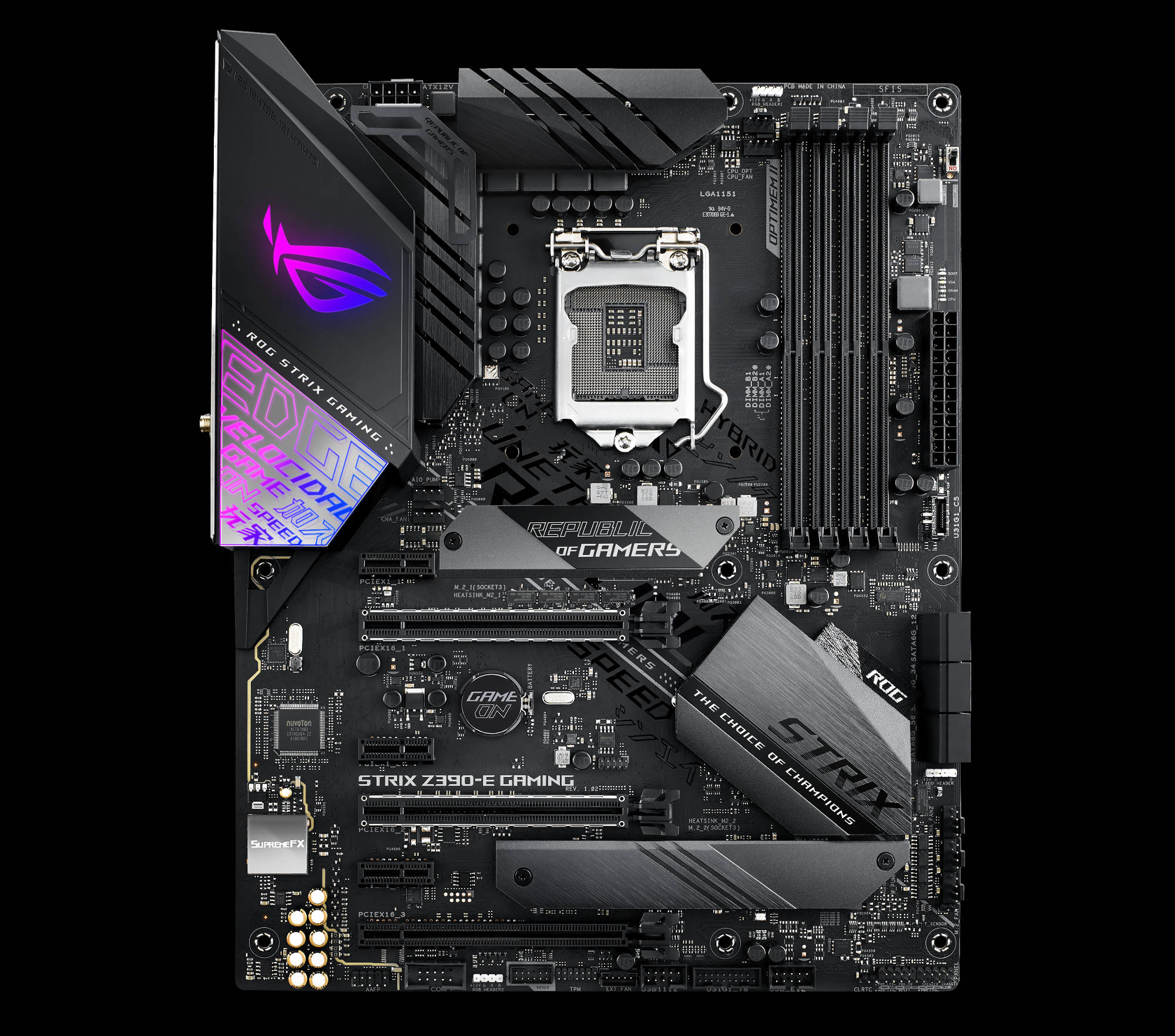
Connectivity may be the most important distinction between these two. While they feature Intel Gigabit Ethernet, only the Strix Z390-E Gaming offers comparable wireless throughput. In fact, it uses the same cutting-edge 802.11ac Wave 2 WiFi controller as the Maximus XI Extreme. The Z390-E also adds a front-panel USB 3.1 Gen 2 connector, while the Z390-F is designed for chassis with Gen 1 ports up front.
The Strix Z390-E Gaming adds perks like built-in WiFi to a balanced foundation for overclocking and gaming, easily justifying its $244.99 USD and $318.99 CAD asking prices. Ask your local ASUS ROG representative whether the Strix Z390-F is available in your region.
Back to basics with the Strix Z390-H Gaming
Our most affordable ROG Strix model lowers the price while still honoring the brand. The Strix Z390-H Gaming reprises the classic black-and-red colorway of our past with an updated attitude that fits ROG’s present. Although we typically stick to monochrome palettes to avoid clashing with customized illumination, extensive RGB lighting is less common on inexpensive machines, so we add a splash of color on the motherboard to compensate. There’s also an Aura Sync header for RGB strips if you want to add system lighting to start or upgrade down the road.
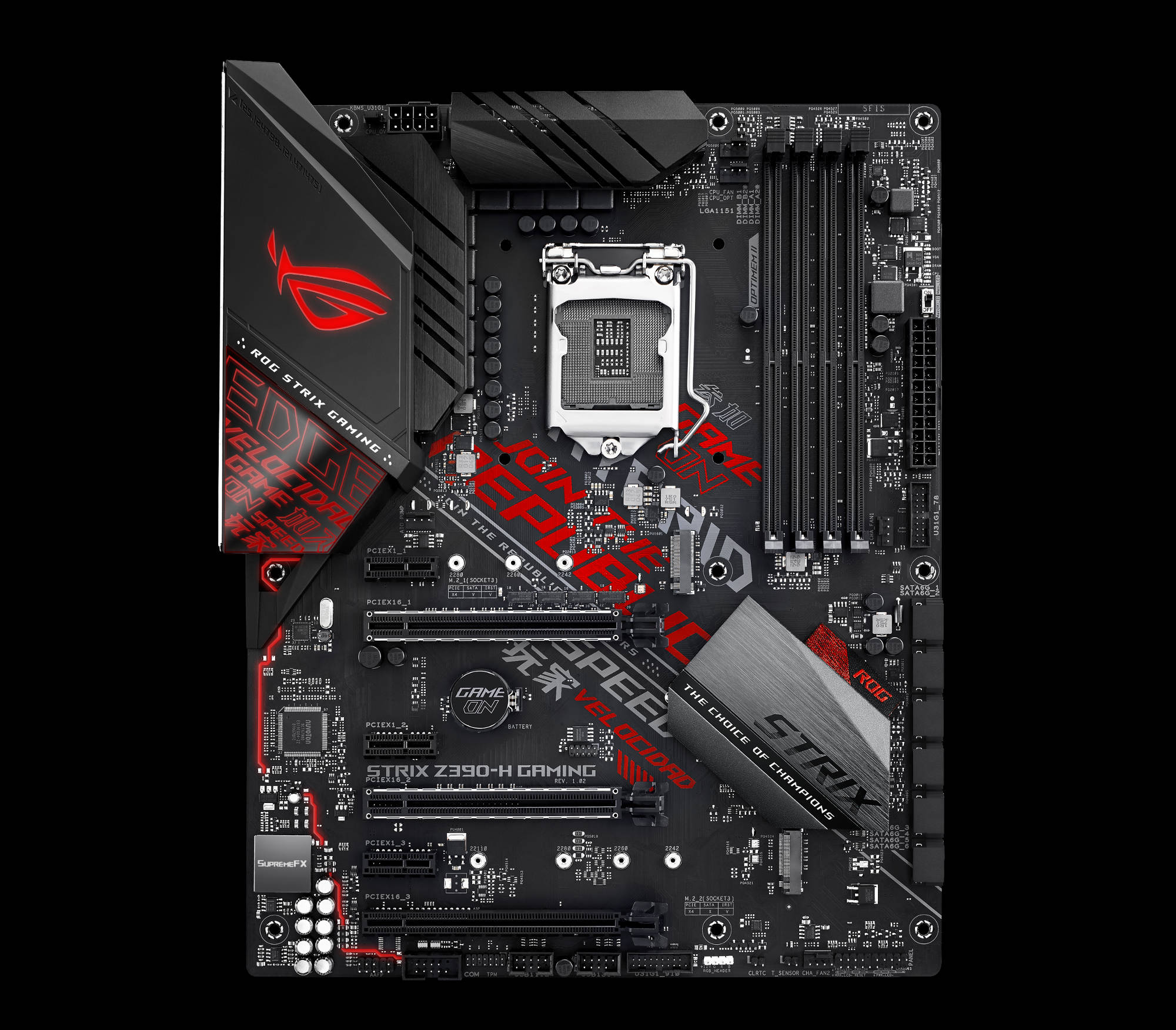
We’ve been granted a patent for the pre-mounted I/O shield that first appeared on ROG motherboards. A relatively simple feature on the surface, this enhancement makes installation much easier than conventional designs that rely on a separate shield, where you typically have to navigate sharp bits of metal and remember the shield in the first place. Pre-mounted I/O shields are now available on every single ROG motherboard down to the Strix Z390-H Gaming.
A hero in letter only, the Z390-H inherits other features from its high-end counterparts, like optimized memory trace routing and automatic recovery from failed boots. But in some areas it scales back to better fit the class of system people actually build with entry-level motherboards. This is an unlikely home for a massively overclocked Core i9 CPU, for example, so the power circuitry isn’t as robust as on pricier models meant for top-of-the-line CPUs. Newer features like AI Overclocking, Node connectivity, and addressable RGB lighting are also absent from what is ultimately a baseline board.
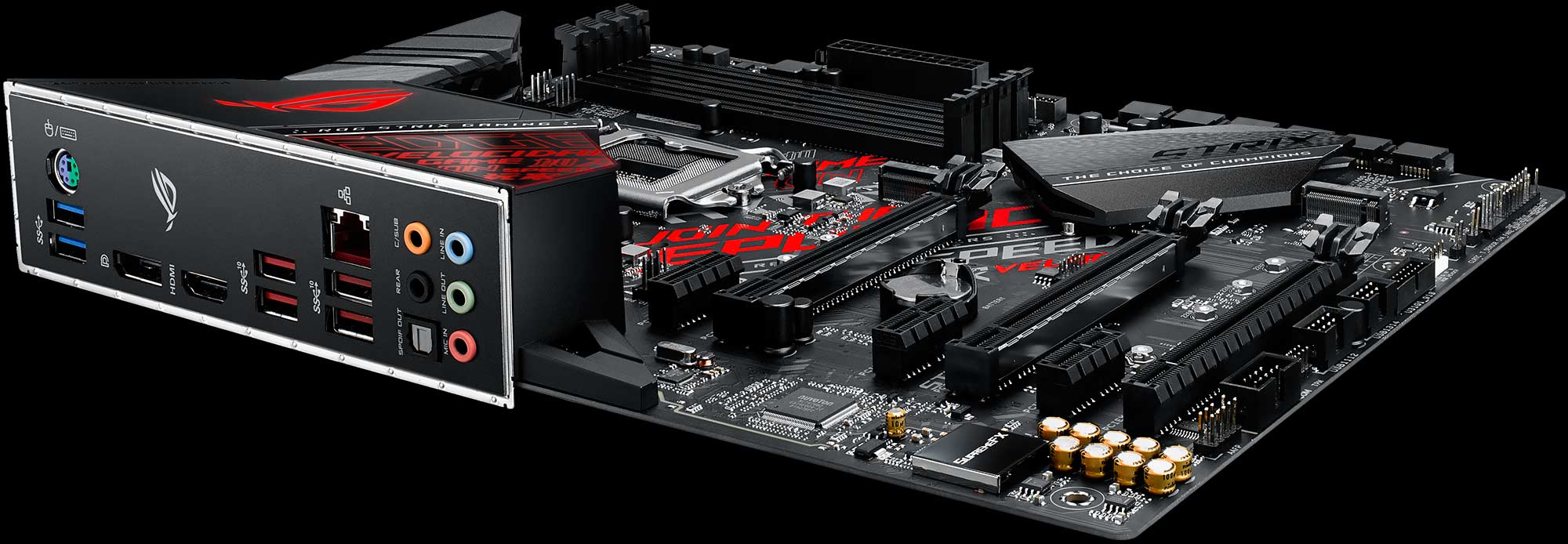
Even the ROG baseline nails the essentials, though. The integrated audio matches more expensive models with a shielded SupremeFX S1220A codec connected to dual amplifiers. A reliable Intel controller supplies the Gigabit Ethernet networking, and our updated ROG GameFirst V software is on-hand to route packets. The latest version of GameFirst includes a new mode that passes application-specific packets without deeper inspection, which can reduce latency for online gaming. It also supports ROG First, which compatible routers can use to prioritize traffic from our motherboards above everything else.
Less certainly isn’t more on the ROG Strix Z390-H Gaming, but for basic builds it’s more than enough considering the price tag. The Strix Z390-H Gaming is available for pre-order at the retailers in the table above for only $189.99 USD and $246.99 CAD.
- motherboards
- Maximus XI Extreme
- Maximus XI Formula
- Maximus XI Code
- Maximus XI Hero Wi-Fi
- Maximus XI Gene
- Strix Z390-E Gaming
- Strix Z390-F Gaming
- Strix Z390-I Gaming
- Strix Z390-H Gaming
- TUF Z390-PRO Gaming
- TUF Z390M-PRO Gaming Wi-Fi
- TUF Z390-PLUS Gaming Wi-Fi
- Prime Z390-A
- Prime Z390-P
- Prime Z390M-PLUS
- WS Z390 PRO
- Z390
- ROG Z390
- ASUS Z390
- Strix Z390
- Z390 Guide
- Product
